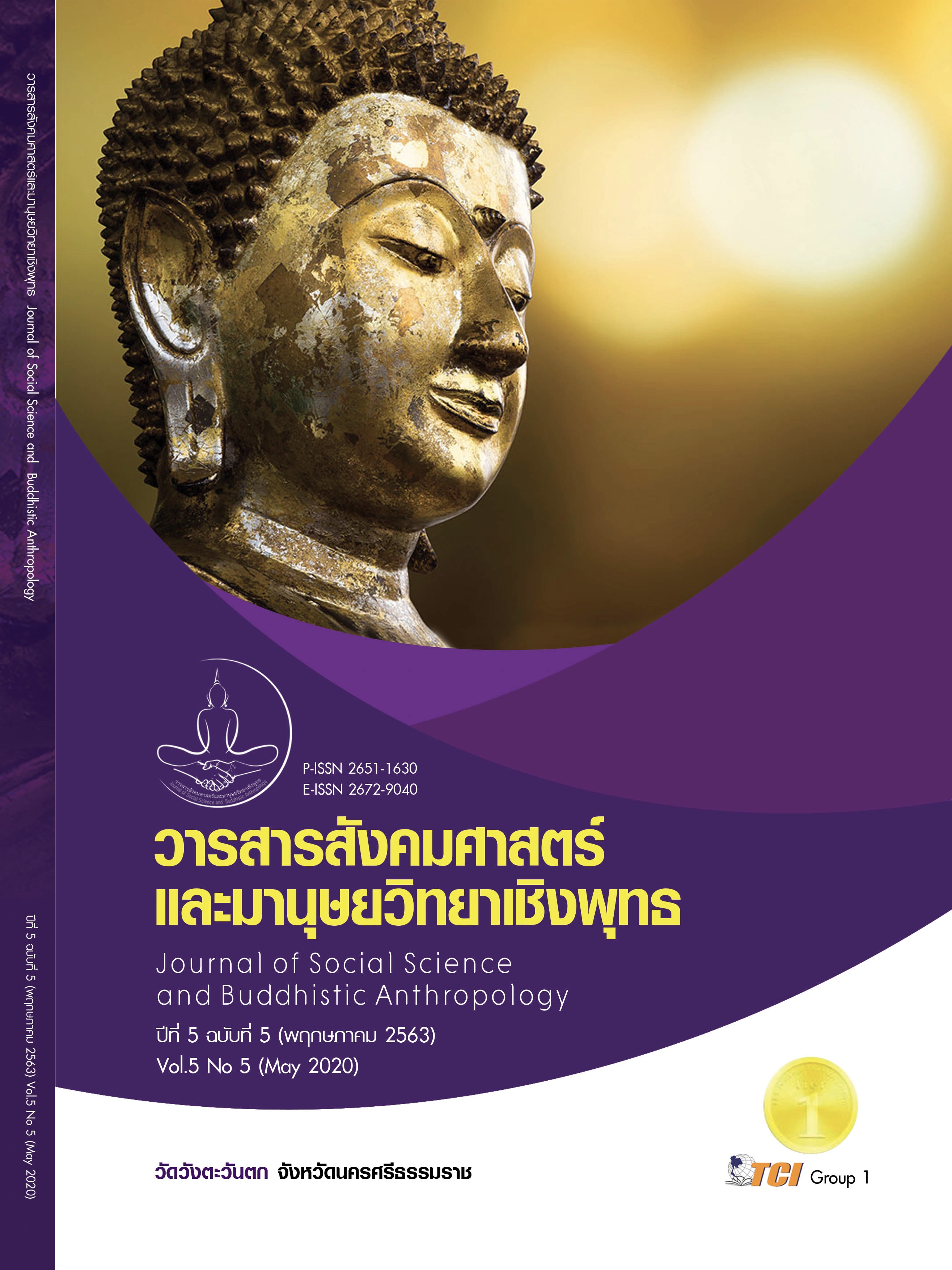HAPPINESS ENHANCEMENCE OF DHAMMA PRACETICE CONTENTBASED ON MAHASATIPATTHANASUTTA
Keywords:
Happiness Enhancemence, Dhamma Pracetice, MahasatipatthanasuttaAbstract
The objectives of the Research paper are 1) to study the concept relealing with happiness enhancemence. 2) to study Dhamma Pracetice Based on Mahasatipatthanasutta. 3) to present the model about the Happiness Enhancement of Dhamma Pracetice Content Based on Mahasatipatthanasutta. This Paper was a qualitative with documentary research, and field work with In-Depth Interview from key informants, by using the analysis description. The research was found that. 1) The concept of enhancing happiness can be concluded that. The way of the modern nation states that, happiness is an important goal for life. But data from the reality in society reverse. Individuals were not as happy as they should be, because they did not understand life, obsessed with the happiness of consumerism, which causing more mental problems. There are more difficult matter to solve avoidance from desire Incoming. Looking at happiness in the material dimension, make neglected of mind. Causing them to be easily moved. That is called Lack of immunity. 2) The Dharma practice Based on Mahasatipatthanasutta will cultivate in the content of using mindfulness as the guiding principle of practice, in Body, Feeling-Sensation, Mind, and Dharma, 3) The model about the Happiness Enhancement of Dhamma Pracetice Content, Based on Mahasatipatthanasutta was the way to enhance happiness into the mind, creating a culture of good human-Being that have Mindfulness mind-set. The mind is firm, free from Greed, Anger, Infatuation. Lead to the happy life. knowledge obtained from research as the Model "Mindfulness mind-set, happy create life". Sum up in C4 Model, Cultivate, Center, Consultant, Create.
References
คณะกรรมการกองการวิปัสสนาธุระแห่งประเทศไทย. (2533). สมเด็จพระพุฒาจารย์กับการวิปัสสนาธุระ. กรุงเทพมหานคร: มหาจุฬาลงกรณราชวิทยาลัย.
จำรูญ ยาสมุทร. (2552). คู่มือการปฏิบัติวิปัสสนากรรมฐานตามแนววิปัสสนาวงศ์พระอรหันต์. เชียงใหม่: ชมรมเผยแพร่พระพุทธศาสนา.
ชุติมา สุรเศรษฐ. (2554). ความสุขของนิสิตนักศึกษาในบริบทพุทธธรรม: การศึกษาข้อมูลเชิงประจักษ์และการพัฒนามาตรวัด. ใน ดุษฎีนิพนธ์ศิลปศาสตรดุษฎีบัณฑิต สาขาจิตวิทยา. จุฬาลงกรณ์มหาวิทยาลัย.
พระครูธรรมธรสุขสันต์ สุจิตฺโต. (15 ต.ค. 2562). การเสริมสร้างความสุขในบริบทของการปฏิบัติธรรมตามแนวสติปัฏฐานสูตร. (นางนนทิวัต ไล้เลิศ, ผู้สัมภาษณ์)
พระธรรมโกศาจารย์ (ประยูร ธมฺมจิตฺโต). (2551). คนเก่งและดีต้องมีความสุข. เรียกใช้เมื่อ 25 เมษายน 2563 จาก http://www.dhammajak.net/board/viewtopic.php?t=436
พระธรรมธีรราชมหามุนี (โชดก ญาณสิทฺธิ). (2538). ความเป็นมาของวิปัสสนากรรมฐาน. กรุงเทพมหานคร: มหาจุฬาลงกรณราชวิทยาลัย.
พระพรหมคุณาภรณ์ (ป.อ.ปยุตฺโต). (2546). ความสุข 5 ชั้น. เรียกใช้เมื่อ 17 ตุลาคม 2562 จาก http://www.cdthamma.com/"www.cdthamma.com
พระมหาสุทิตย์ อาภากโร. (2556). สุขที่ได้ธรรม. นนทบุรี: ดีไซน์ดีไลท์ จำกัด.
พระเมธาวินัยรส (สุเทพ ปสิวิโก). (26 ก.ย. 2562). การเสริมสร้างความสุขในบริบทของการปฏิบัติธรรมตามแนวสติปัฏฐานสูตร. (นางนนทิวัต ไล้เลิศ, ผู้สัมภาษณ์)
รศรินทร์ เกรย์ และคณะ. (2553). ความสุขเป็นสากล. นครปฐม: สถาบันวิจัยประชากรและสังคม มหาวิทยาลัยมหิดล.
สวนดุสิตโพล มหาวิทยาลัยสวนดุสิต. (2562). สิ่งที่ประชาชนวิตกกังวล. เรียกใช้เมื่อ 8 กันยายน 25562 จาก http://www.thairath-lund.or.th/"www.thairath-lund.or.th
สำนักงานคณะกรรมการพัฒนาเศรษฐกิจและสังคมแห่งชาติ. (2558). แผนพัฒนาเศรษฐกิจและสังคมแห่งชาติ ฉบับที่ 12. เรียกใช้เมื่อ 3 มีนาคม 2563 จาก http://www.nesdb.go.th
สำนักงานคณะกรรมการวิจัยแห่งชาติ. (2561). ประเทศที่อันตรายสำหรับนักท่องเที่ยวมากที่สุดในโลก. เรียกใช้เมื่อ 3 มีนาคม 2563 จาก thip12@hotmail.com
อรัญญา ตุ้ยคัมภีร์. (2561). สร้างพื้นนิสัยทางบวกและความสุข. เรียกใช้เมื่อ 23 ตุลาคม 2561 จาก www.http:// thaihealth.or.th
อาจอง ชุมสาย ณ อยุธยา. (2543). Mind-Set. วารสารท่องโลกการศึกษา, 1(1), 32-58.








